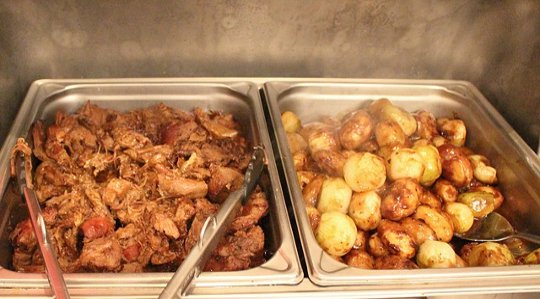
Nutritionist Lindsey Berkson, M.A., D.C., of Santa Fe, New Mexico, sees today's typical American diet as containing too few foods. "Unfortunately, most Americans tend to avoid variety and commit the dietary sin of monotony," she says, "eating the same foods meal after meal, only disguised by different names." They also consume food not according to what is best for them but according to what tastes best to them.
According to Dr. Berkson, the American menu is actually made of various combinations of the same foods, usually wheat, beef, eggs, potatoes, and milk products. For example, she points out, a breakfast of eggs, sausage, white toast, and hash browns is the same as a lunch of a hamburger, white bun, and fries, which is the same as a dinner of steak and potatoes or white pasta.
James Braly, M.D., medical director of Immuno Laboratories and author of Dr. Braly's Food Allergy & Nutrition Revolution, concurs with Dr. Berkson's perspective. He reports that Americans typically get 80% of their calories from 11 types of foods, and that among these foods are the most highly allergenic: milk, eggs, wheat, rye, nuts, and soy. What's the connection? A leaky gut.
If you suffer from intestinal permeability and constantly eat the same foods over and over again, undigested molecules from these foods will frequently leak into the bloodstream, activating an allergic response. "A repetitive diet can contribute greatly to the development of allergies," says Marshall Mandell, M.D., medical director for the New England Foundation for Allergies and Environmental Diseases. "If someone eats bread every day, for instance, he could easily develop a wheat allergy due to the immune system's continuous exposure to it."
A main step in eliminating allergies is to vary your diet. If you are no longer triggering allergic reactions and sending your immune system into chaos, you can begin the process of healing your leaky gut and immune function. The rotation diet is a good way to change your repetitive, allergy-inducing eating habits.
Allergic Addiction Syndrome
Do you ever crave a particular food? Can't imagine going through the day without bread or cheese or chocolate? You may believe that these urges are good, that your body is signaling you that it needs these foods to remain healthy. However, these cravings often mean the exact opposite -- that your body is being assaulted by these foods. This is called the allergic addiction syndrome.
Allergy to addictive foods develops as any other allergy does -- with a leaky gut and improper digestion. One day you eat cheese; for some reason, your gastrointestinal system is unable to fully break down the cheese molecules. Some undigested molecules escape through the intestinal barrier and enter your bloodstream, leading to sensitization. When you consume cheese again and macromolecules again leak through the gut wall, an antibody-mediated allergic reaction ensues. Among the chemicals released during this immune process are narcotic-like substances called opioids, which help the body deal with ("mask") the discomfort caused by the allergic reaction. These opioids are like tranquilizers with a boost; they give you an immediate physical and emotional high. After a while, the inflammatory response subsides, and so does the opioid high. Your spirits and energy levels flag.
As with any addiction, you will begin to crave this opioid lift and the food that triggered it. The more you eat the allergenic food, however, the more damage it does to your body. The type III (arthus) allergic reactions that occur during allergic addiction damage cells. Additionally, the constant release of opioid chemicals and accompanying stress hormones (such as cortisol, which also provides an energy boost) exhausts the adrenal glands and the nervous system. Without the food, you will begin to feel withdrawal symptoms, including nervousness, shakiness, fatigue, weakness, perhaps headaches. But you need to eat larger quantities of the allergenic food for your brain to release greater amounts of feel-good chemicals to fight the withdrawal symptoms. Over time, you will truly be addicted to the offending food, bingeing on it, while your body deteriorates as a result of the allergic inflammation.
Dietary Lectins
If you've ever read the diet book Eat Right 4 Your Type by Peter D'Adamo, N.D., you're familiar with the concept of lectins, types of proteins found in beans, grains, and soy, as well as in pollens, bacteria, and viruses. These proteins are able to bind with specific sugars on the surface of all cells of the body. This feature enables lectins to clump cells together for various biochemical functions, some of which are beneficial. Lectins found on cells in the liver's bile duct bind with bacteria and parasites, clumping them together, and facilitating their elimination from the body. Lectins can also perform pathogenic roles; for example, lectins on bacteria and viruses stick like Velcro? to mucosal linings in our body, causing irritation and infection. Dietary lectins are particularly damaging to the gastrointestinal linings. One study found that dietary lectins, especially those found in lentils, induced a significantly large release of histamine, causing tissue inflammation. Soybean and wheat lectins can produce an increase in permeability in the cells they bind to, often leading to cell death. Further, lectins can cause the intestinal villi (the fingerlike projections that give the intestine its absorptive surface area) to atrophy.
Some lectins also cause illness in individuals with certain blood types, while promoting health in those with different blood types. Blood is classified into four blood types or groups according to the presence of type A and type B antigens on the surface of red blood cells. These antigens are also called agglutinogens and pertain to the blood cells' ability to agglutinate, or clump together. Blood type A contains antibodies to type B, and vice versa. Blood type O carries antibodies for both type A and type B. Blood type AB has no antibodies to any blood type. Blood type is considered relevant to food allergy because agglutination also occurs in the body in response to lectins.
Lectins are found in 30% of the foods we eat; they have characteristics similar to blood antigens and can thus sometimes become an "enemy" when they enter the body. Nutritionist Ann Louise Gittleman, M.S., C.N.S., author of Your Body Knows Best, notes that there are 65 different lectins known to have an agglutination reaction in the body, leading to intestinal damage, disrupted digestion and absorption, and food allergy, among other health problems. Milk lectins are similar to type B blood cells. If someone with type A blood consumes milk, anti-B antibodies will be mobilized, causing an allergic reaction. However, milk is generally well tolerated in people with type B blood. Gluten, a lectin found in wheat and other grains, counteracts strongly with type O blood and tends to cause gastrointestinal inflammation. Tomatoes provoke strong reactions in type A and B blood types, but are often properly absorbed by types O and AB.
In general, our immune systems protect all of us -- regardless of blood type -- from lectins entering the bloodstream. However, according to Dr. D'Adamo, approximately 5% of dietary lectins do enter our blood, likely due to intestinal permeability.
Commonly Reactive Foods
If you were to ask ten doctors to name their patients' top offending foods and food additives, chances are their lists would look similar to this one, compiled from patient tests in my practice. Testing was done with electrodermal screening. Note that these foods and additives are found, in varying combinations, in most processed foods.
| Item Tested | Testing Positive |
| Wheat
Egg BHA (preservative_ BHT (preservative) Fluoride Corn Peanut Cow's Milk Soy Red Dye Monosodium Glutamate (MSG) Nitrates Nitrites Sulfite Yellow Dye (tartrazine) Bluy Dye Sorbic Acid Sulfur Dioxide Violet Dye Chicken Turkey Hydrolyzed Vegetable Protein Beef Nutrasweet? Chocolate Bacon Tuna Tabasco Sauce Pork Cane Sugar |
73%
70% 70% 70% 70% 68% 68% 68% 68% 68% 68% 65% 65% 65% 62% 62% 62% 62% 57% 57% 57% 54% 51% 49% 46% 46% 43% 43% 41% 41% |
Lectins and Cross-Reactivity
Over the years, physicians have noticed that some patients who are allergic to certain pollens are also allergic to certain foods. For example, people with ragweed pollen allergy often are allergic to foods in the Curcubitaceae family (watermelon, melon, and cucumber) as well as banana. Why is this so? It appears that lectins are partly responsible for this cross-reactivity -- edible plant foods contain lectins also found in common pollens. This may also be the reason that people with allergies to latex also experience banana allergy.
Here are some other common instances of cross-reactivity that may be due to shared lectin content:
- Birch Pollen -- apple, carrot, potato, kiwis, and hazelnut
- Mugwort pollen -- carrot, celery, nuts, mustard greens, and legumes
- Grass pollen -- tomato, potato, green peas, peanut, watermelon, melon, apple, orange, and kiwi
- Plantain pollen -- melon
The Candidiasis Connection
There are more than 400 species of bacteria living in the human body and the majority of these bacteria reside in the gastrointestinal tract. Under conditions of intestinal health, "friendly" bacteria (such as Lactobacillus acidophilus and Bifidobacterium bifidum) predominate and contribute to digestion and the overall health of the body. But, increasingly, the shift observed today is towards a predominance of pathogenic bacteria, a condition of intestinal imbalance called dysbiosis. The unfriendly or pathogenic bacteria that dominate the intestines impair digestion, the absorption of nutrients, and the normal elimination cycle. They also provoke allergic reactions to food and contribute to the erosion of the intestinal mucosa and the infiltration of inappropriate substances into the bloodstream -- a condition referred to as "leaky gut syndrome."
Dysbiosis is considered a primary cause or major cofactor in the development of many health problems, such as rheumatoid arthritis, acne, chronic fatigue, depression, digestive disorders, bloating, PMS, cancer, and food allergies. Of the pathogenic organisms most significantly implicated in food allergy is the yeast Candida albicans; its overgrowth is called candidiasis.
The modern North American way of eating is largely responsible for dysbiosis. The foods we eat are not pure and, to an extent, full of poisons. The typical diet is replete with meat products, which contain large amounts of chemical residues from the pesticides and herbicides used in livestock feed, and hormones and antibiotics used to make the animals grow larger and more rapidly. Ingestion of antibiotics, either through food products or prescribed medications, severely alters the intestinal flora by killing off bacteria, including beneficial microorganisms. As the bacterial communities repopulate after prolonged use of antibiotics, the colonic environment favors the growth of disease-causing organisms in lieu of the healthier bacteria.
We also tend to eat too many of the nutritionally wrong foods. Consider the huge amount of sugar and refined carbohydrates found in what's called the Standard American Diet (SAD). It is a sad diet indeed, for it has led to a nation with a staggering number of obese individuals and has caused chronic aberrations in the digestive flora. The SAD decreases the amount of intestinal secretions that aid in the proper breakdown of foods and this favors the overgrowth of pathogenic microorganisms.
Article Source:
 Allergy Free: An Alternative Medicine Definitive Guide
Allergy Free: An Alternative Medicine Definitive Guide
by Konrad Kail, N.D. and Bobby Lawrence with Burton Goldberg.
Reprinted with permission of the publisher, AlternativeMedicines.com. ©2000 http://www.AlternativeMedicine.com
Click here for more info and/or to order this book.
About the Authors
Konrad Kail, N.D., is co-owner of Naturopathic Family Care, Inc., a naturopathic group practice in Phoenix, Arizona, that provides integrated -- conventional as well as complementary and alternative -- medical services, emphasizing prevention and natural therapeutics. Dr. Kail was certified as a Physician's Assistant and received a B.S. in Medicine from Baylor College of Medicine in 1976 and a doctorate in Naturopathic Medicine (N.D.) from the National College of Naturopathic Medicine and Health Sciences in 1983. He is a Fellow of the American College of Naturopathic Family Medicine and Minor Surgery.
Bobbi Lawrence is a freelance writer based in Larkspur California.
Burton Goldberg, Ph.D., Hon., has published Alternative Medicine: The Definitive Guide, a1100-page reference book, hailed as "the bible of alternative medicine". For information, go to www.alternativemedicine.com
























